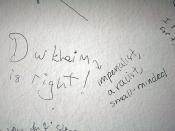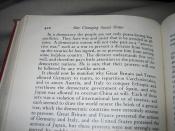How are death rituals indicative of aspects of identity? Discuss with examples.
If one thing is truly universal in this world, it must surely be death. Everything that lives will definitely die. However, the ways in which it is rationalised and handled are incredibly diverse, so too is the concept of morality, which are all dependent on ones culture and society. Death is central dynamism underlying the life, vitality and structure of the social order, and so profoundly affecting the individual and their identity. It can be utilised as a barometer to measure the adequacy of social life, through indicators such as life expectancy, homicide and suicide rates. It can be argued that funerary evidence is perhaps the very first indicator of sapiens' humanity: for example, the remains of a Neanderthal middle-aged man, covered in flowers and found laid to rest in the foetal position, whose relative longevity despite deformity indicates the support of others.
Archaeological evidence suggests that humans, while once simply discarding their dead, started to assume a mournful role, making graves and depositing with in their various momentos. These momentos ranged from flower petals to flint, foetal positions to facing east, animal bones to horns, and other adornments and rituals supplementing the basic corpse. This ritualistic approach evolved from Neanderthal and especially Cro-Magnon times. Like paleoanthropologists one can attempt to delineate the identity of our forefathers, but by studying their death rituals, as opposed their skulls and bones, and using aetiology rather than phenomenology.
The ideas associated with death, the fears, hopes and orientations one has towards it, are not intrinsic. Death is socially constructed, learnt from public symbols such as religious and funerary rituals, which in turn reflect aspects of social affiliation and identity. It could be said that death is a catalyst, which when put...


